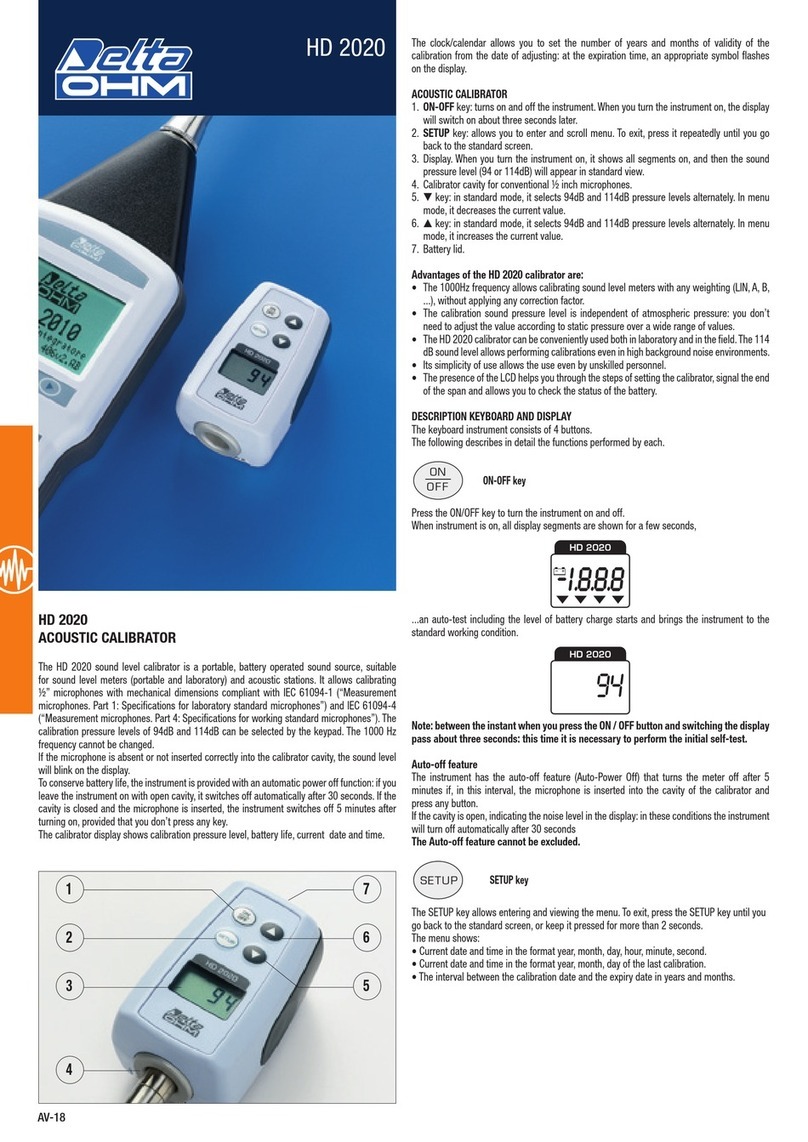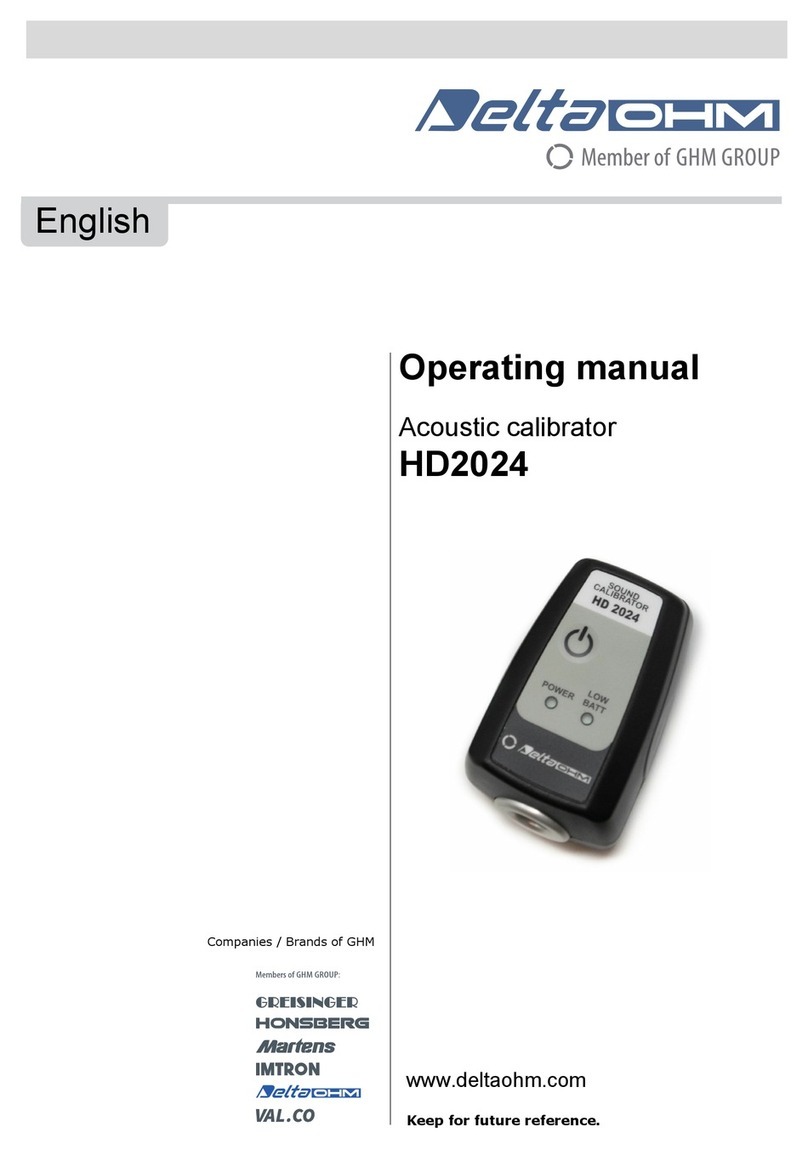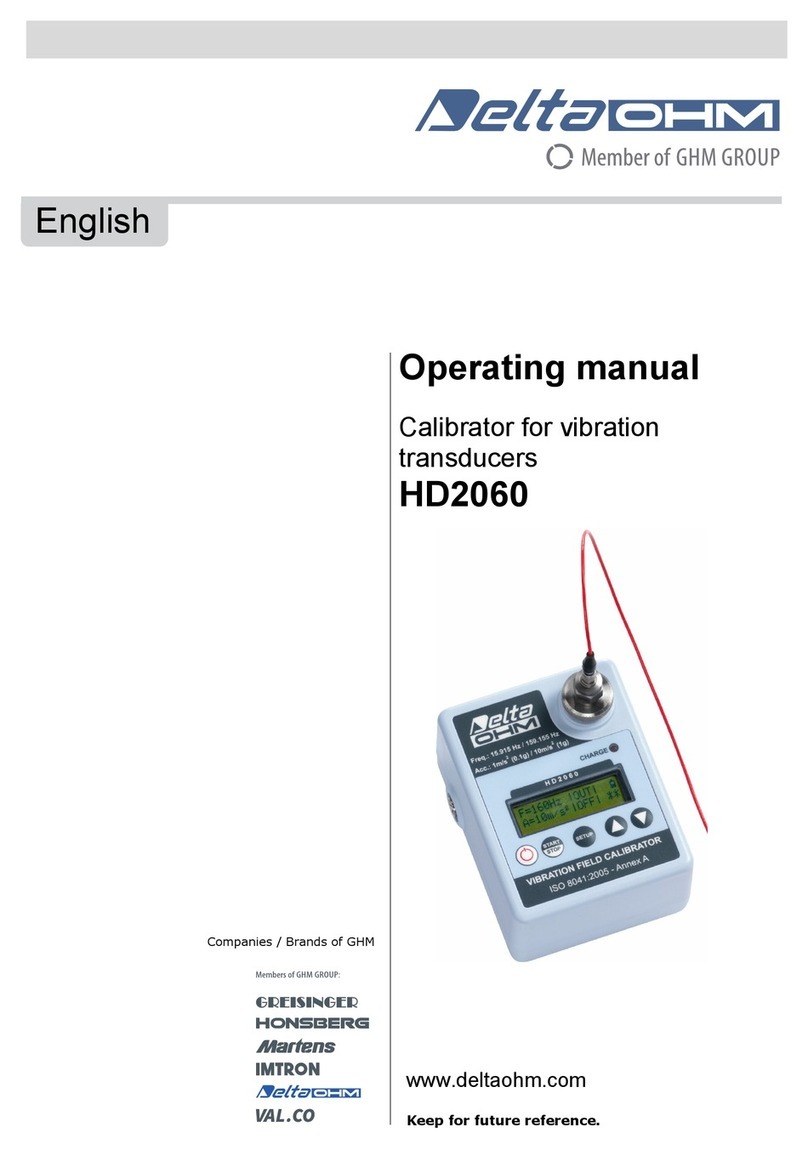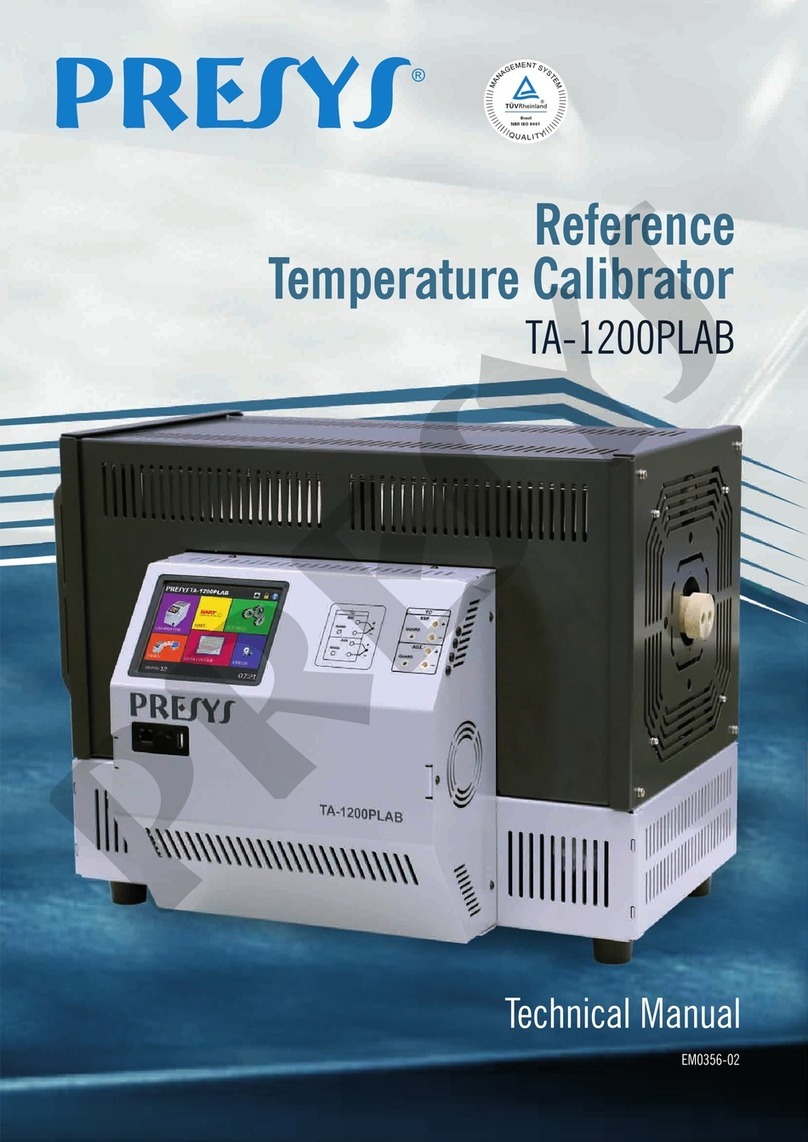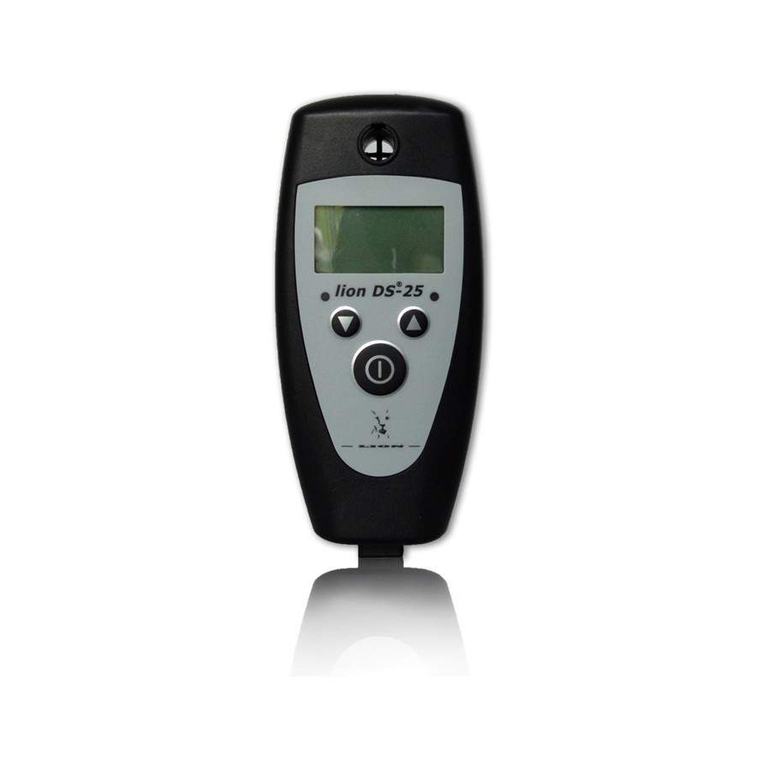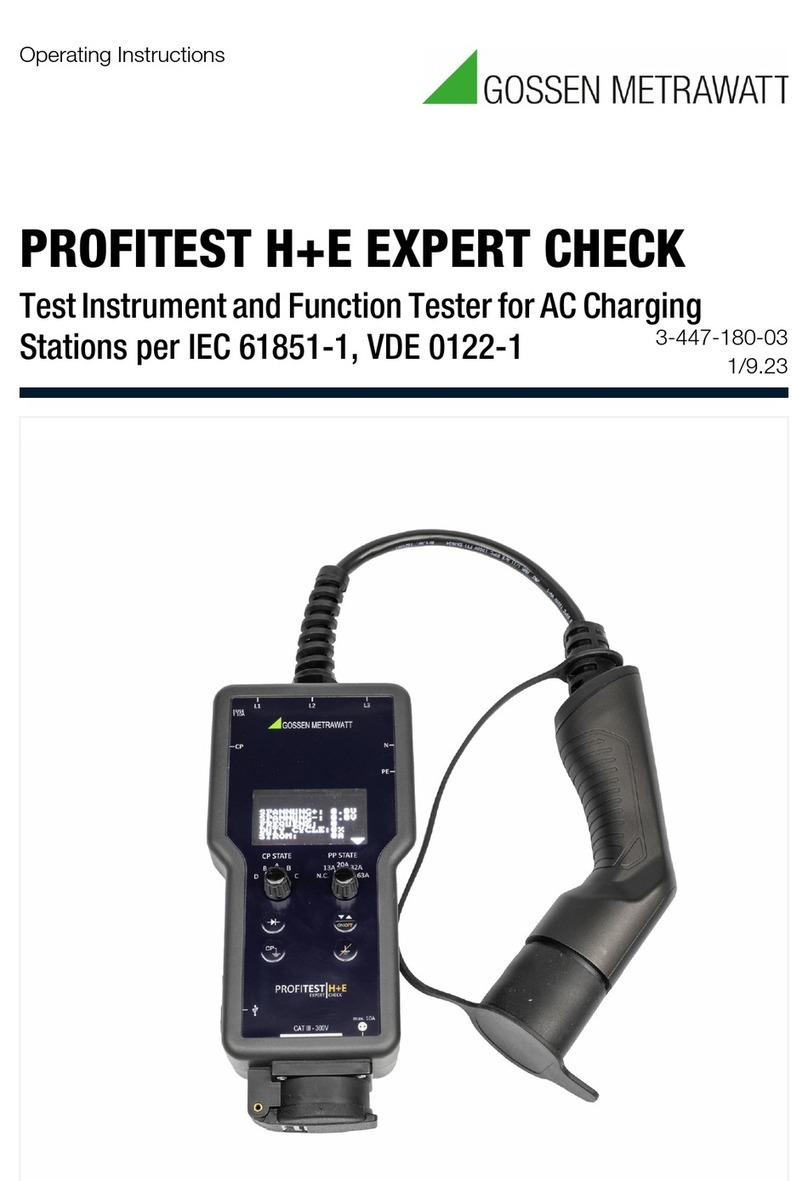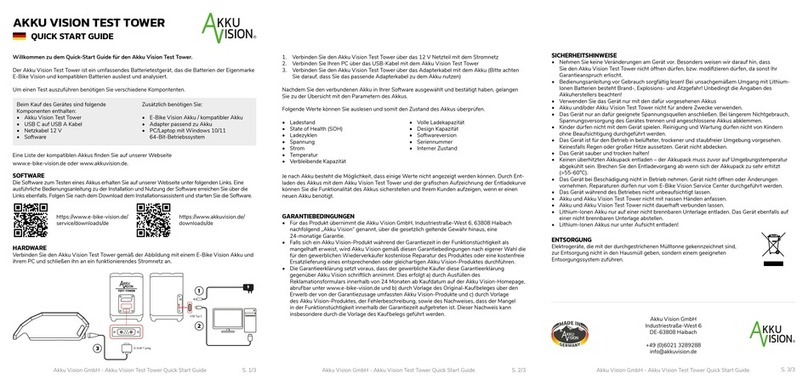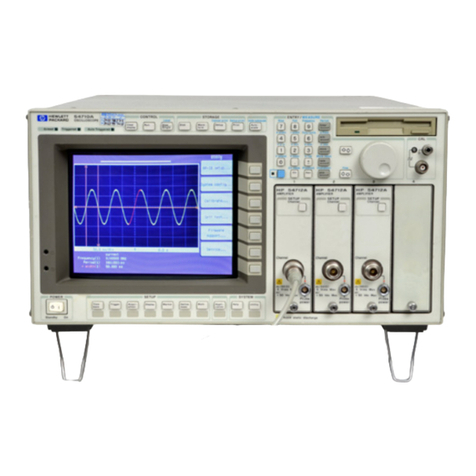Delta OHM HD2060 User manual

HD 2060
H D 2 0 6 0
START
STOP
VIBRATION FIELD CALIBRATOR
ISO 8041:2005 - Annex A
Freq.: 15.915 Hz / 159.155 Hz
Acc.: 1m/s (0.1g) / 10m/s (1g)
2 2
CHARGE
SETUP
** DELTA OHM **
** HD2060 **
Base vibrante
LED ricarica batteria
LCD
Tastiera
Connettore
alimentatore
AV-44
The calibrator HD2060 generates mechanical vibration amplitude controlled with
precision and frequency stabilized by a quartz. Coupling a transducer to the vibrating
base of the calibrator it is possible to check its sensitivity to acceleration, velocity or
displacement. The presence of a rechargeable internal battery, the weight and the small
dimensions as well as the low sensitivity to environmental parameters make it easy to
use the calibrator in the eld. The calibrator is equipped with a feedback system capable
of accurately maintaining the amplitude level set, regardless of the load associated with
the mass of the transducer (within the limits stated in the technical specications).
The mechanical vibrations generated by the calibrator are very stable over the time, with
a typical drift of 1% per year. In order to maintain the accuracy, we recommend the annual
calibration at DELTA OHM metrological laboratories. The calibrator notifies the user about
the need to make the periodic check by displaying alternately the signs “cal” and “exp”
on the display.
The backlit display provides a clear indication of acceleration, frequency and the reaching
of the set level. In case of exceeding the maximum permissible load or in case of low
battery, the calibrator alerts the user by displaying an error message and the operation of
the vibrating base is turned off. The automatic stop of the vibration after the set time and
the automatic shutdown function prevent the discharge of the battery.
The calibrator is equipped with screws and accessories for mounting the transducers,
with external power supply for charging the battery and with calibration report.
Applications:
•
In-the-eld calibration of acceleration, velocity and displacement transducers.
•
Calibration of acceleration sensors used for the measurement of vibrations transmitted
to men in the workplace, according to the standard ISO 8041:2005.
•
Calibration of acceleration sensors used to evaluate buildings vibration.
Main specifications:
•
Two frequencies of emission: 15,915 Hz at 1 m/s2and 0,1 g
159,155 Hz at 10 m/s2and 1 g
•
Low distortion accelerations, independent from the mass of the transducer
•
Absence of dispersed magnetic field
•
Backlit display with the indication of the acceleration level stabilization
•
Internal rechargeable battery which allows 2 hours of continuous operation at 15.915
Hz and 7 hours of continuous operation at 159.155 Hz.
Fig. 1: Description
SPECIFICATIONS
Maximum load of the
vibrating base
Traction force: 10 N
Pressure: 30 N
Transverse: 2 N
Mass of the transducer Maximum 150 g at 15,915 Hz
Maximum 30 g at 159,155 Hz
Emission frequency
tolerance ± 0,1%
Emission amplitude
tolerance ± 3%
Distortion Less than 3% at 15,915 Hz
Less than 0,5% at 159,155 Hz
Duration of individual
emission Settable from 120 sec to 10 min . Automatic turn OFF
Transverse acceleration Less than 10% at 15,915 HzLess than 20% at 159,155 Hz
Mounting of the
transducer Threaded hole UNF 10-32 at 90° ±1°
Working temperature/RH 0…+40 °C / 0…85 %UR not condensing
Stabilization time Less than 30 s
Display
Backlit with indication of:
Frequency generated
Acceleration generated
Stabilization of the vibration
Remaining battery charge
Calibration deadline
Power supply
Rechargeable NiMH battery pack 1.2V x 4,
capacity 1600 mA/h (BAT-40)
Stabilized power supply voltage 100-240 Vac / 12 Vdc 1 A
(SWD10)
Authonomy with full
charged battery
2 hours of continuous use at 15,915 Hz
7 hours of continuous use at 159,155 Hz
Battery charging time 4 hours at 12 Vdc 1A
Auto power off After an inactive period of time equal to 3 times the time
of solicitation set
Dimensions 115 x 93 x 63 mm
Weight 930 g including battery
HD2060
PORTABLE MULTI-FREQUENCY AND MULTI-LEVEL CALIBRA-
TOR FOR VIBRATION TRANSDUCERS
Power
connector
Vibrating base
Battery Charge LED
LCD
Keyboard

M 30 NAX M 10 NAX M 2 NAX
HD 2060.20
HD 6245.1
Trasduttore
Base vibrante
Vite di fissaggio del
trasduttore
HD 2060.20
Trasduttore
Base vibrante
Base
vibrante
Vite con doppia filettatura
per il fissaggio dell’accessorio
HD 2060.20 alla base vibrante
Trasduttore
Contrappeso
Base vibrante
M 30 NAX M 10 NAX M 2 NAX
HD 2060.20
HD 6245.1
Trasduttore
Base vibrante
Vite di fissaggio del
trasduttore
HD 2060.20
Trasduttore
Base vibrante
Base
vibrante
Vite con doppia filettatura
per il fissaggio dell’accessorio
HD 2060.20 alla base vibrante
Trasduttore
Contrappeso
Base vibrante
M 30 NAX M 10 NAX M 2 NAX
HD 2060.20
HD 6245.1
Trasduttore
Base vibrante
Vite di fissaggio del
trasduttore
HD 2060.20
Trasduttore
Base vibrante
Base
vibrante
Vite con doppia filettatura
per il fissaggio dell’accessorio
HD 2060.20 alla base vibrante
Trasduttore
Contrappeso
Base vibrante
H D 2 0 6 0
START
STOP
VIBRATION FIELD CALIBRATOR
ISO 8041:2005 - Annex A
Freq.: 15.915 Hz / 159.155 Hz
Acc.: 1m/s (0.1g) / 10m/s (1g)
2 2
CHARGE
SETUP
93 63
115
M 30 NAX M 10 NAX M 2 NAX
HD 2060.20
HD 6245.1
Trasduttore
Base vibrante
Vite di fissaggio del
trasduttore
HD 2060.20
Trasduttore
Base vibrante
Base
vibrante
Vite con doppia filettatura
per il fissaggio dell’accessorio
HD 2060.20 alla base vibrante
Trasduttore
Contrappeso
Base vibrante
Acoustics - Vibrations
AV-45
TRASDUCER MOUNTING
The calibrator HD2060 presents a at circular steel xing base (see Figure 1), resistant
to abrasions, with a threaded hole in the center UNF 10-32 for the mounting of the
transducers. The fixing base can freely rotate on its housing so as to avoid damage
to the calibrator when mounting the sensors and applying the tightening. To fix the
accelerometer using a screw it’s sufcient a 1-2Nm tightening force, compatible with a
manual operation. For maximum measurements repeatability, the use of a torque wrench
is recommended.
Maximum applicable forces to the xing base are: 30N pressure force, 10N traction force
and 2N transverse force (see picture 2). Applying a load which exceeds specified
limits can permanently damage the HD2060 calibrator.
Fig. 2: maximum load limits for vibrating base
As an alternative to screw mounting, it’s possible to fix the sensor onto vibrating base
using double-sided tape, wax or quick glue; for this can be used the supplied insulated
base HD6245.1 (see picture n.3) to be mounted between vibrating base and transducer. To
avoid an excessive pressure on the vibrating base, we recommend to glue the transducer
on the HD6245.1 adapter before screwing it to the vibrating base.
Fig. 3: Adhesive Mounting
To calibrate axes orthogonal to the mounting axis on triaxial accelerometers, is supplied
the adapter HD2060.20, complete with UNF10-32 dual threading screw to x the adapter
to the mounting base and screw with UNF10-32 threading to x the sensor to the adapter
(see picture n 4).
ORDERING CODES
HD2060: Portable calibrator for acceleration, velocity and displacement transducers.
Double emission frequency 15.915 Hz (amplitudes 1 m/s2 and 0.1 g) and
159.155Hz (amplitudes 10m/s2 and 1g). Backlit LCD display. Power supply with
internal rechargeable battery or external 12Vdc power supply. Includes: support
(HD2060.20) for triaxial accelerometers mounting, rechargeable internal battery
(BAT-40), power supply (SWD10), carrying case and calibration report, HD6245.1
insulated base for adhesive mounting.
Accessories
SWD10: Stabilized power supply 100-240 Vac / 12 Vdc 1 A.
BAT-40: Rechargeable NiMH battery pack 1,2V x 4 .
HD6245.1: Base with integrated UNF 10-32 screw. To be used for adhesive mounting
HD2060.20: Support for the lateral mounting of tri-axial accelerometers with 10-32 UNF
mounting screw
Fig. 4: Use of adapter HD 2060.20
If you use the HD2060.20 adapter to calibrate at 16 Hz perpendicular axis of a triaxial
accelerometer having a mass greater than 30 g, it is necessary to balance the load using
a counterweight equal to that of the transducer to be mounted, as shown in figure 5.
Fig. 5: Use of counterweights
Calibrator must be placed on a flat horizontal surface, possibly free from external
vibrations. In order to check that transmitted vibration level from supporting surface is
negligible it is sufficient, after transducer has been fixed to the mounting base, to verify
that acceleration on the measurement chain with calibrator turned OFF is below 1/5 of
calibration level. For example, if a calibration has to be made at 15,915Hz with 1m/s2
amplitude level, acceleration on the measurement chain when calibrator is OFF should
be less than 0,2m/s2.
During calibration solicitation it’s necessary to avoid unbalances on the base, taking care
of transducer’s connection cable positioning, in order to minimize the transverse load.
Transducer should be mounted so that the load is centered on the base.
BATTERY CHARGE
The battery symbol on the display continuously provides the charge battery status. As
the battery discharges, the symbol “empties”. When the charge is insufcient for correct
device operation , the symbol starts blinking and it will be not possible to activate the
emission of the vibrating base.
In order to charge the batteries, connect the SWD10 power supply to the input plug
positioned on the calibrator’s side. During battery charge, the “CHARGE” red LED is ON.
The LED will turn OFF when the charge is completed. The time necessary for a full charge
is about 4 hours.
Power supply has a dual function: supplies the device and charges the NiMH battery.
When power supply is plugged in, the battery symbol on the display, is substituted by the
symbol of a plug.
In order to preserve over time the battery capacity, it is recommended to make a
complete charge cycle at least one time every two months.
DIMENSIONS (mm)
Vibrating Base
Vibrating Base
Counterweight
Vibrating Base
Transducer’s mounting
screw
Double threading screw for
mounting of HD 2060.20 on
Vibrating base
Transducer
Triaxial
transducer
Transducer
Vibrating
Base
Other manuals for HD2060
1
Other Delta OHM Test Equipment manuals
Popular Test Equipment manuals by other brands
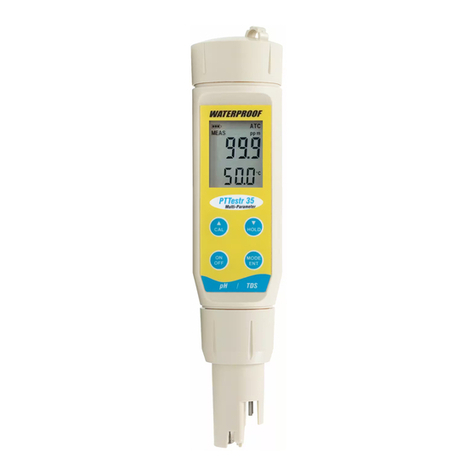
EUTECH INSTRUMENTS
EUTECH INSTRUMENTS ECOTESTR PH 2 operating instructions
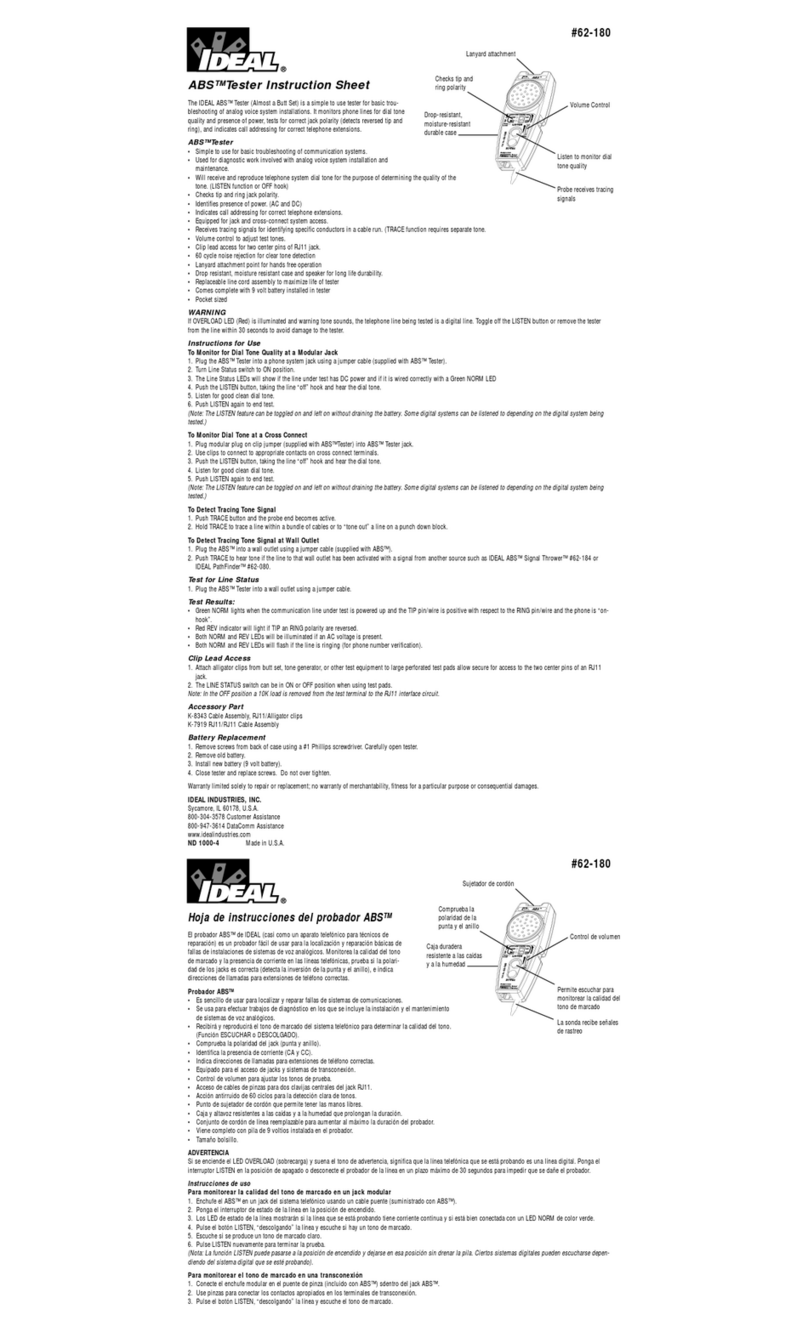
IDEAL INDUSTRIES
IDEAL INDUSTRIES ABS instruction sheet
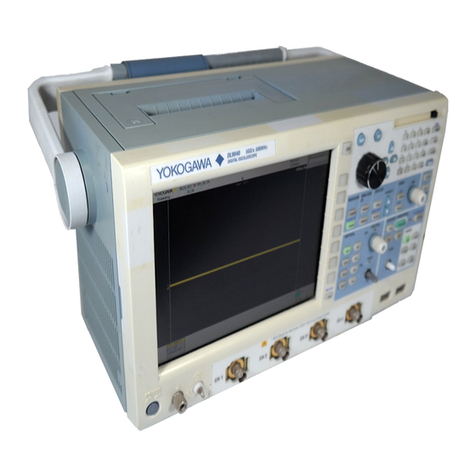
YOKOGAWA
YOKOGAWA DL9040 Series user manual

Seaward
Seaward Solar PV150 operating instructions
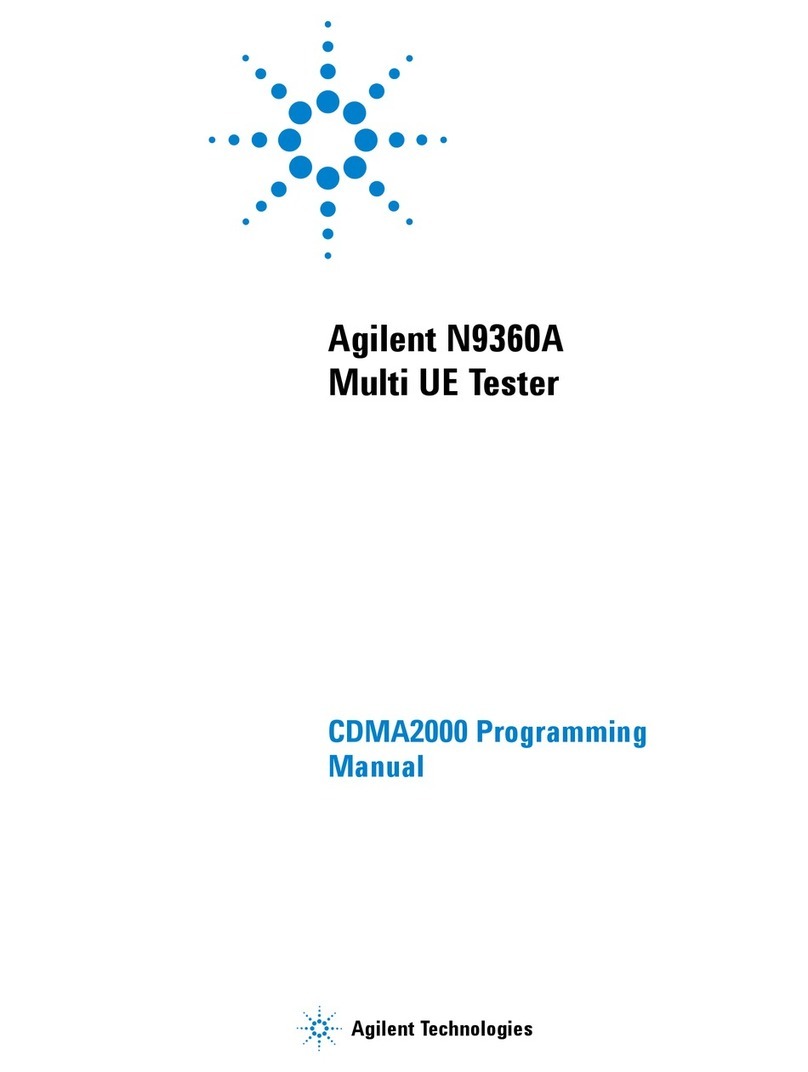
Agilent Technologies
Agilent Technologies N9360A Programming manual
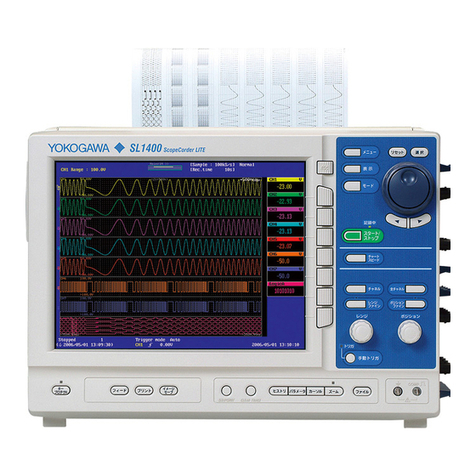
YOKOGAWA
YOKOGAWA SL1400 ScopeCorder LITE Operation guide

AEMC
AEMC OX 7102 Quick start user guide
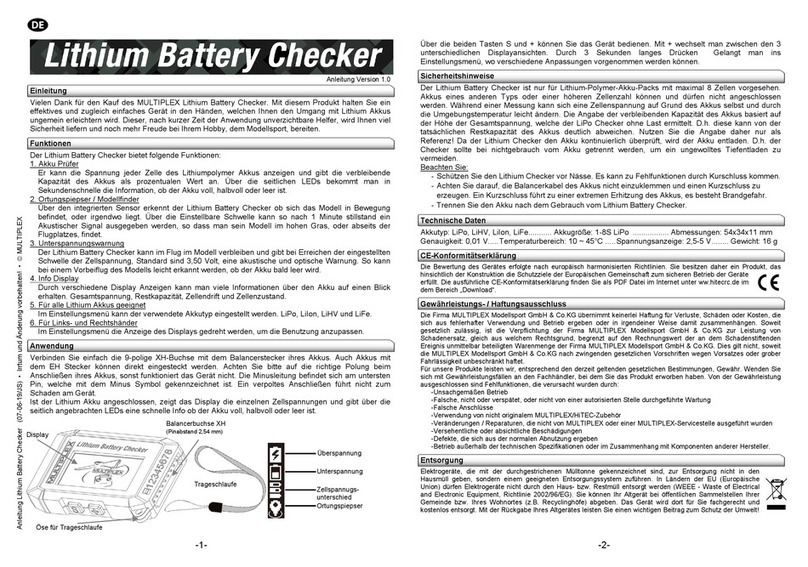
Multiplex
Multiplex Lithium Battery Checker quick start guide
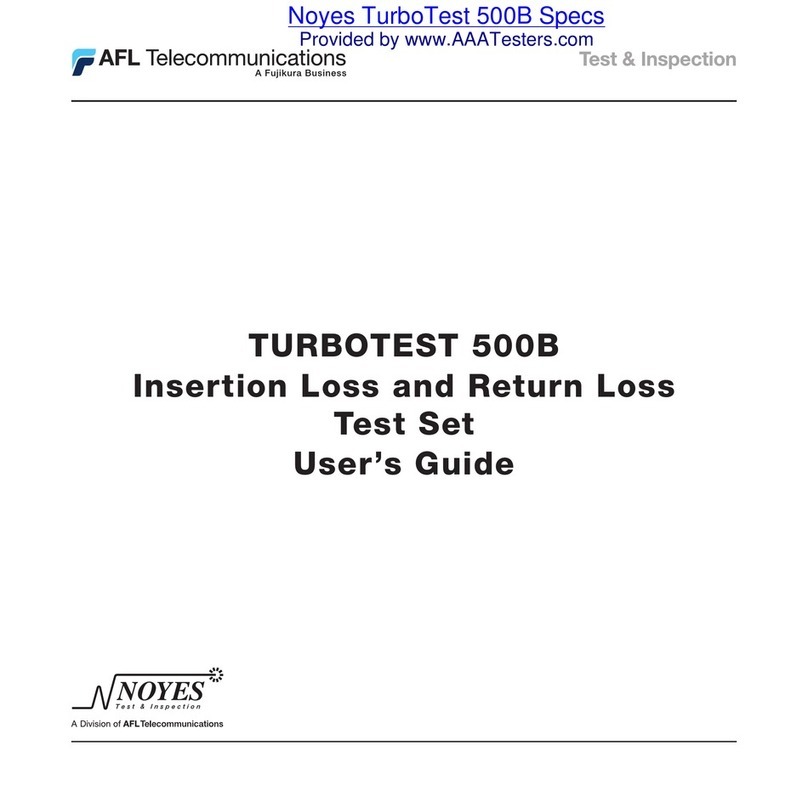
Fujikura
Fujikura AFL Telecommunications NOYES TURBOTEST 500B user guide

System Sensor
System Sensor RTS151 Installation and maintenance instructions
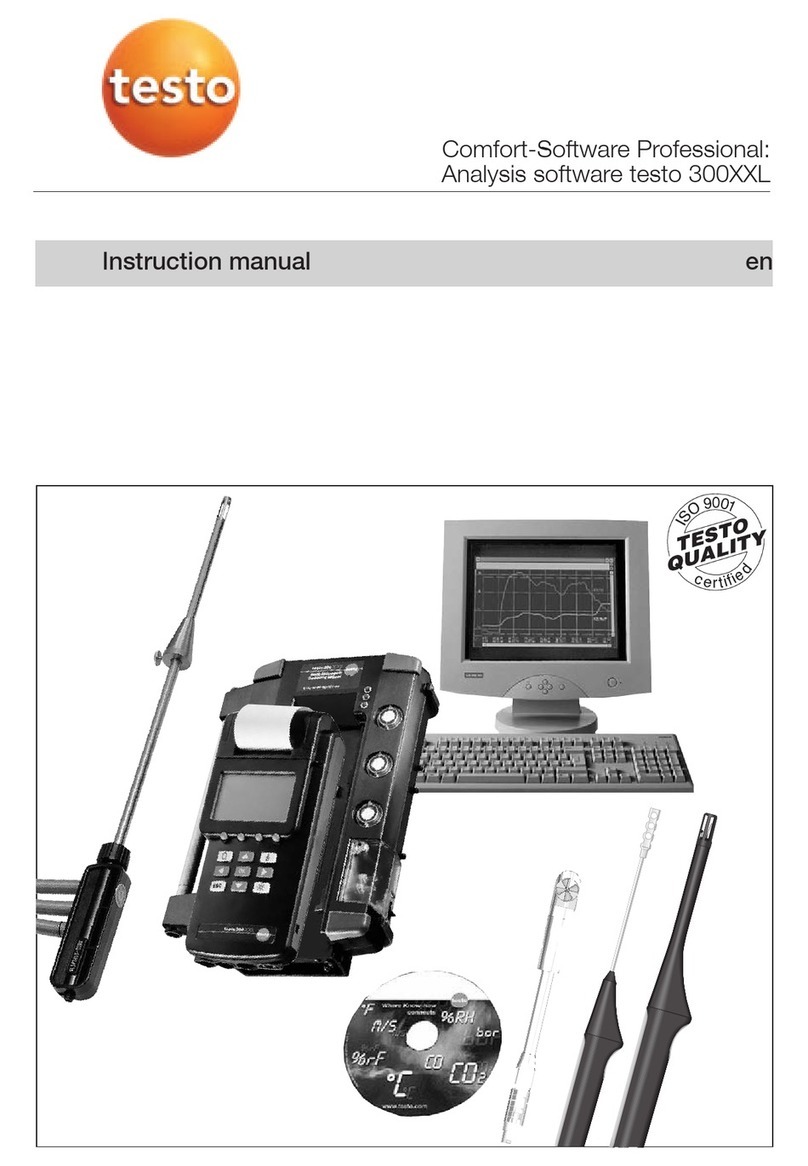
TESTO
TESTO 300 XXL instruction manual
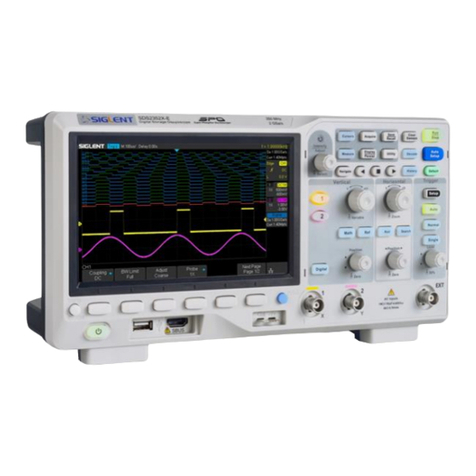
SIGLENT
SIGLENT SDS2000X-E Series user manual
